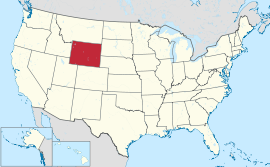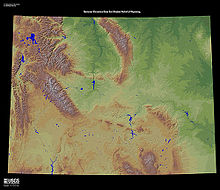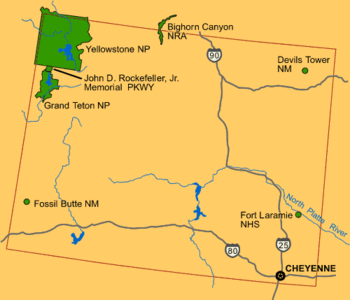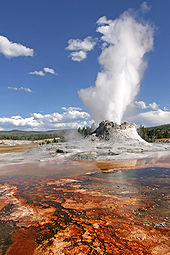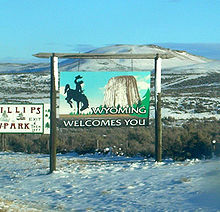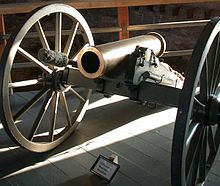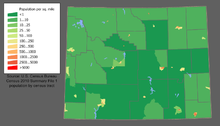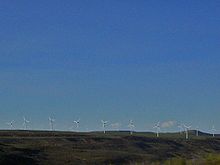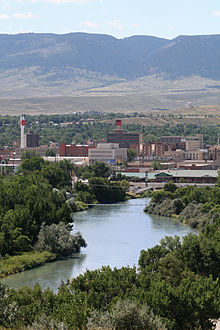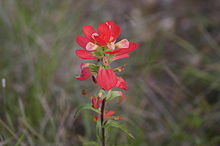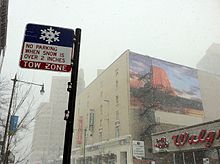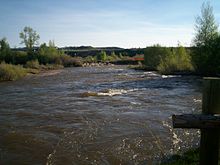- Wyoming
-
"Wy" redirects here. For the Australian micronation, see Principality of Wy.
State of Wyoming 

Flag Seal Nickname(s): Equality State (official);
Cowboy State; Big WyomingMotto(s): Equal Rights Official language(s) English Demonym Wyomingite Capital
(and largest city)Cheyenne Largest metro area Cheyenne Metro Area Area Ranked 10th in the U.S. - Total 97,814 sq mi
(253,348 km2)- Width 280 miles (450 km) - Length 360 miles (581 km) - % water 0.7 - Latitude 41°N to 45°N - Longitude 104°3'W to 111°3'W Population Ranked 50th in the U.S. - Total (2010)563,626[1] - Density 5.4/sq mi (2.08/km2)
Ranked 49th in the U.S.Elevation - Highest point Gannett Peak[2][3][4]
13,809 ft (4209.1 m)- Mean 6,700 ft (2040 m) - Lowest point Belle Fourche River at South Dakota border[3][4]
3,101 ft (945 m)Before statehood Wyoming Territory Admission to Union July 10, 1890 (44th) Governor Matt Mead (R) Secretary of State Max Maxfield (R) Legislature Wyoming Legislature - Upper house Senate - Lower house House of Representatives U.S. Senators Mike Enzi (R)
John Barrasso (R)U.S. House delegation Cynthia Lummis (R) (list) Time zone Mountain: UTC-7/-6 Abbreviations WY US-WY Website wyoming.gov Wyoming
 i/waɪˈoʊmɪŋ/ is a state in the mountain region of the Western United States. The western two thirds of the state is covered mostly with the mountain ranges and rangelands in the foothills of the Eastern Rocky Mountains, while the eastern third of the state is high elevation prairie known as the High Plains. Wyoming is the least populous U.S. state, with a U.S. Census population of 563,626 in 2010. This is a 14.1% increase since 2000.[1] It is the tenth largest U.S. state by area. Cheyenne is the capital and the most populous city of Wyoming with a population of nearly 60,000 people within its city proper.
i/waɪˈoʊmɪŋ/ is a state in the mountain region of the Western United States. The western two thirds of the state is covered mostly with the mountain ranges and rangelands in the foothills of the Eastern Rocky Mountains, while the eastern third of the state is high elevation prairie known as the High Plains. Wyoming is the least populous U.S. state, with a U.S. Census population of 563,626 in 2010. This is a 14.1% increase since 2000.[1] It is the tenth largest U.S. state by area. Cheyenne is the capital and the most populous city of Wyoming with a population of nearly 60,000 people within its city proper.Contents
Geography and climate
Location and size
As specified in the designating legislation for the Territory of Wyoming, Wyoming's borders are lines of latitude, 41°N and 45°N, and longitude, 104°3'W and 111°3'W (27° W and 34° W of the Washington Meridian), making the shape of the state a latitude-longitude quadrangle.[5] Wyoming is one of only three states (along with Colorado and Utah) to have borders along only straight latitudinal and longitudinal lines, rather than being defined by natural landmarks. Due to surveying inaccuracies during the 19th century, Wyoming's legal border deviates from the true latitude and longitude lines by up to half of a mile (.8 km) in some spots, especially in the mountainous region along the 45th parallel.[6] Wyoming is bordered on the north by Montana, on the east by South Dakota and Nebraska, on the south by Colorado, on the southwest by Utah, and on the west by Idaho. It is the tenth largest state in the United States in total area, containing 97,818 square miles (253,350 km2) and is made up of 23 counties. From the north border to the south border it is 276 miles (444 km);[7] and from the east to the west border is 365 miles (587 km) at its south end and 342 miles (550 km) at the north end.
Mountain ranges
The Great Plains meet the Rocky Mountains in Wyoming. The state is a great plateau broken by many mountain ranges. Surface elevations range from the summit of Gannett Peak in the Wind River Mountain Range, at 13,804 feet (4,207 m), to the Belle Fourche River valley in the state’s northeast corner, at 3,125 feet (953 m). In the northwest are the Absaroka, Owl Creek, Gros Ventre, Wind River and the Teton ranges. In the north central are the Big Horn Mountains; in the northeast, the Black Hills; and in the southern region the Laramie, Snowy and Sierra Madre ranges.
The Snowy Range in the south central part of the state is an extension of the Colorado Rockies in both geology and appearance. The Wind River Range in the west central part of the state is remote and includes more than 40 mountain peaks in excess of 13,000 ft (4,000 m) tall in addition to Gannett Peak, the highest peak in the state. The Big Horn Mountains in the north central portion are somewhat isolated from the bulk of the Rocky Mountains.
The Teton Range in the northwest extends for 50 miles (80 km), part of which is included in Grand Teton National Park. The park includes the Grand Teton, the second highest peak in Wyoming.
The Continental Divide spans north-south across the central portion of the state. Rivers east of the divide drain into the Missouri River Basin and eventually the Gulf of Mexico. They are the North Platte, Wind, Big Horn and the Yellowstone rivers. The Snake River in northwest Wyoming eventually drains into the Columbia River and the Pacific Ocean, as does the Green River through the Colorado River Basin.
The continental divide forks in the south central part of the state in an area known as the Great Divide Basin where the waters that flow or precipitate into this area remain there and cannot flow to any ocean. Instead, because of the overall aridity of Wyoming, water in the Great Divide Basin simply sinks into the soil or evaporates.
Several rivers begin or flow through the state, including the Yellowstone River, Bighorn River, Green River, and the Snake River.
Public lands
More than 48% of the land in Wyoming is owned by the U.S. Government, leading Wyoming to rank sixth in the U.S. in total acres and fifth in percentage of a state's land owned by the Federal government.[8] This amounts to about 30,099,430 acres (121,808.1 km2) owned and managed by the U.S. Government. The state government owns an additional 6% of all Wyoming lands, or another 3,864,800 acres (15,640 km2).[8]
The vast majority of this government land is managed by the Bureau of Land Management and U.S. Forest Service in numerous National Forests, a National Grassland, and a number of vast swaths of public land, in addition to the F.E. Warren Air Force Base near Cheyenne.
In addition, Wyoming contains areas that are under the management of the National Park Service and other agencies. They include:
Parks
Recreation areas
- Bighorn Canyon National Recreation Area
- Flaming Gorge National Recreation Area (Forest Service-Ashley National Forest)
National monuments
National historic trails and sites
- California National Historic Trail
- Independence Rock (Wyoming)
- Fort Laramie National Historic Site
- Medicine Wheel National Historic Site
- Mormon Pioneer National Historic Trail
- National Register of Historic Places listings in Wyoming
- Oregon National Historic Trail
- Pony Express National Historic Trail
National parkways
- John D. Rockefeller, Jr. Memorial Parkway between Yellowstone National Park and Grand Teton National Park
Wildlife refuges and hatcheries
- Seedskadee National Wildlife Refuge
- National Elk Refuge
- Jackson National Fish Hatchery
- Saratoga National Fish Hatchery

Panoramic view of the Teton Range looking west from Jackson Hole, Grand Teton National Park. Climate
Wyoming's climate is generally semi-arid and continental (Köppen climate classification BSk), and is drier and windier in comparison to most of the United States with greater temperature extremes. Much of this is due to the topography of the state. Summers in Wyoming are warm with July high temperatures averaging between 85 °F (29 °C) and 95 °F (35 °C) in most of the state. With increasing elevation, however, this average drops rapidly with locations above 9,000 feet (2,700 m) averaging around 70 °F (21 °C). Summer nights throughout the state are characterized by a rapid cooldown with even the hottest locations averaging in the 50–60 °F (10–16 °C) range at night. In most of the state, most of the precipitation tends to fall in the late spring and early summer. Winters are cold, but are variable with periods of sometimes extreme cold interspersed between generally mild periods, with Chinook winds providing unusually warm temperatures in some locations. Wyoming is a dry state with much of the land receiving less than 10 inches (250 mm) of rainfall per year. Precipitation depends on elevation with lower areas in the Big Horn Basin averaging 5–8 inches (130–200 mm) (making the area nearly a true desert). The lower areas in the North and on the eastern plains typically average around 10–12 inches (250–300 mm), making the climate there semi-arid. Some mountain areas do receive a good amount of precipitation, 20 inches (510 mm) or more, much of it as snow, sometimes 200 inches (510 cm) or more annually. The states highest recorded temperature is 114 °F (46 °C) at Basin on July 12, 1900 and the lowest recorded temperature is −66 °F (−54 °C) at Riverside on February 9, 1933.
The climate of any area in Wyoming is largely determined by its latitude, altitude and local topography. When put together, these factors have a lot to do with airflow patterns, temperature variations, precipitation and humidity brought in by the weather systems that migrate eastward. In winter, Wyoming is often beneath the jet stream, or north of it, which accounts for its frequent strong winds, blasts of Arctic air and precipitation, all the necessary ingredients for great snow conditions at Wyoming's northwestern ski areas. In summer, the jet stream retreats northward to Canada, leaving the state's weather mild and pleasant at a time when the majority of Wyoming's visitors choose to arrive. Jackson, located at 6,230 feet (1,900 m) above sea level and surrounded by mountains, can expect a high temperature in July of 80 °F (27 °C). The average is more likely to be 65 °F (18 °C). The closest National Weather Station (in Riverton on the other side of the Wind River Mountains at 4,955 feet (1,510 m)) reports slightly warmer July weather.
The number of thunderstorm days vary across the state with the southeastern plains of the state having the most days of thunderstorm activity. Thunderstorm activity in the state is highest during the late spring and early summer. The southeastern corner of the state is the most vulnerable part of the state to tornado activity. Moving away from that point and westwards, the incidence of tornadoes drops dramatically with the west part of the state showing little vulnerability. Tornadoes, where they occur, tend to be small and brief, unlike some of those that occur a little further east.
Casper climate: Average maximum and minimum temperatures, and average rainfall. Month Jan Feb Mar Apr May Jun Jul Aug Sep Oct Nov Dec Year Average max. temperature °F (°C) 32
(0)37
(3)45
(7)56
(13)66
(19)78
(26)87
(31)85
(29)74
(23)60
(16)44
(7)34
(1)58
(14)Average min. temperature
°F (°C)12
(-11)16
(-9)21
(-6)28
(-2)37
(3)46
(8)54
(12)51
(11)41
(5)32
(0)21
(-6)14
(-10)31
(-1)Average rainfall
inches (mm)0.6
(15.2)0.6
(15.2)1.0
(25.4)1.6
(40.6)2.1
(53.3)1.5
(38.1)1.3
(33.0)0.7
(17.8)0.9
(22.9)1.0
(25.4)0.8
(20.3)0.7
(17.8)12.8
(325.1)Source:[9] Jackson climate: Average maximum and minimum temperatures, and average rainfall. Month Jan Feb Mar Apr May Jun Jul Aug Sep Oct Nov Dec Year Average max. temperature °F (°C) 24
(-4)28
(-2)37
(3)47
(8)58
(14)68
(20)78
(26)77
(25)67
(19)54
(12)37
(3)24
(-4)49
(9)Average min. temperature
°F (°C)-1
(-18)2
(-17)10
(-12)21
(-6)30
(-1)36
(2)41
(5)38
(3)31
(-1)22
(-6)14
(-10)0
(-18)20
(-7)Average rainfall
inches (mm)2.6
(66.0)1.9
(48.3)1.6
(40.6)1.4
(35.6)1.9
(48.3)1.8
(45.7)1.3
(33.0)1.3
(33.0)1.5
(38.1)1.3
(33.0)2.3
(58.4)2.5
(63.5)21.4
(543.6)Source:[10] History
Several American Indian groups originally inhabited the region now known as Wyoming. The Crow, Arapaho, Lakota, and Shoshone were but a few of the original inhabitants encountered when white explorers first entered the region. What is now southwestern Wyoming became a part of the Spanish Empire and later Mexican territory of Alta California, until it was ceded to the United States in 1848 at the end of the Mexican-American War. French Canadian trappers from Québec and Montréal have ventured into the state in the late 18th century, leaving French toponyms such as Téton, La Ramie, etc. John Colter. A member of the Lewis and Clark Expedition, itself guided by French Canadian Toussaint Charbonneau and his young Shoshone wife, Sacagawea, first described the region in 1807. At the time, his reports of the Yellowstone area were considered to be fictional. Robert Stuart and a party of five men returning from Astoria discovered South Pass in 1812. The Oregon Trail later followed that route. In 1850, Jim Bridger located what is now known as Bridger Pass, which the Union Pacific Railroad used in 1868—as did Interstate 80, 90 years later. Bridger also explored Yellowstone and filed reports on the region that, like those of Colter, were largely regarded as tall tales at the time.
The region may have acquired the name Wyoming as early as 1865, when Representative J. M. Ashley of Ohio introduced a bill to Congress to provide a "temporary government for the territory of Wyoming". The name Wyoming derives from the Munsee name xwé:wamənk, meaning "at the big river flat", but also named after the Wyoming Valley in Pennsylvania, made famous by the 1809 poem Gertrude of Wyoming by Thomas Campbell.[11][12]
After the Union Pacific Railroad had reached the town of Cheyenne in 1867, the region's population began to grow steadily, and the federal government established the Wyoming Territory on July 25, 1868.[13] Unlike Colorado to the south, Wyoming enjoyed no significant discovery of such celebrated minerals as gold and silver—nor Colorado's consequent boom in population—although South Pass City experienced a short-lived boom after the Carissa Mine began producing gold in 1867.[14] Moreover, some areas, such as between the Sierra Madre Mountains and the Snowy Range near Grand Encampment, produced copper.[15]
Once government sponsored expeditions to the Yellowstone country were undertaken, the previous reports by men like Colter and Bridger were found to be true. This led to the creation of Yellowstone National Park, which became the world's first national park in 1872. Nearly all of Yellowstone National Park lies within the far northwestern borders of Wyoming.
On December 10, 1869, territorial Gov. John Allen Campbell signed a suffrage act into law, which extended the right to vote to women. And in addition to being the first U.S. state to grant suffrage to women, Wyoming was also the home of other firsts for U.S. women in politics. For the first time, women served on a jury in Wyoming (Laramie in 1870). Wyoming had the first female court bailiff (Mary Atkinson, Laramie, in 1870) and the first female justice of the peace in the country (Esther Hobart Morris, South Pass City, in 1870). Wyoming became the first state in the Union to elect a female governor, Nellie Tayloe Ross, (Wyoming and Texas both elected a female governor at the same time. The Wyoming female Governor took office a few days before the one in Texas did) Source: History of Wyoming by Dr. T. A. Larsonwho was elected in 1924 and took office in January 1925. Because of rights given to women, Wyoming earned the nickname of "The Equality State".[16]
Wyoming's constitution included women's suffrage and a pioneering article on water rights.[17] The United States admitted Wyoming into the Union as the 44th state on July 10, 1890.[16]
Wyoming was the location of the Johnson County War of 1892, on which the controversial 1980 film Heaven's Gate was based, which erupted between competing groups of cattle ranchers. The passage of the federal Homestead Act led to an influx of small ranchers. A range war broke out when either or both of the groups chose violent conflict over commercial competition in the use of the public land.
See: List of counties in Wyoming
Demographics
Historical populations Census Pop. %± 1870 9,118 — 1880 20,789 128.0% 1890 62,555 200.9% 1900 92,531 47.9% 1910 145,965 57.7% 1920 194,402 33.2% 1930 225,565 16.0% 1940 250,742 11.2% 1950 290,529 15.9% 1960 330,066 13.6% 1970 332,416 0.7% 1980 469,557 41.3% 1990 453,588 −3.4% 2000 493,782 8.9% 2010 563,626 14.1% Source: 1910-2010[18] Population
The center of population of Wyoming is located in Natrona County.[19]
As of 2005, Wyoming had an estimated population of 509,293, which was an increase of 3,407, or 0.7%, from the prior year and an increase of 15,512, or 3.1%, since the 2000 census. This includes a natural increase since the last census of 12,165 people (that is 33,704 births minus 21,539 deaths) and an increase from net migration of 4,035 people into the state. Immigration from outside the United States resulted in a net increase of 2,264 people, and migration within the country produced a net increase of 1,771 people. In 2004, the foreign-born population was 11,000 (2.2%). In 2005, total births in Wyoming numbered 7,231 (Birth Rate of 14.04).[20] Sparsely populated, Wyoming is the least populous (total number of people) state of the United States, and has the second lowest population density, behind Alaska. It is the only state with a lower population than the nation's capital, Washington, D.C..
Demographics of Wyoming (csv) By race White Black AIAN* Asian NHPI* 2000 (total population) 96.19% 1.01% 3.06% 0.84% 0.13% 2000 (Hispanic only) 6.05% 0.11% 0.32% 0.06% 0.02% 2005 (total population) 96.01% 1.15% 3.06% 0.90% 0.12% 2005 (Hispanic only) 6.38% 0.15% 0.27% 0.05% 0.01% Growth 2000–05 (total population) 2.95% 17.26% 3.16% 10.32% -3.47% Growth 2000–05 (non-Hispanic only) 2.57% 14.20% 4.95% 12.17% 0.18% Growth 2000–05 (Hispanic only) 8.66% 42.08% -12.31% -14.09% -28.40% * AIAN is American Indian or Alaskan Native; NHPI is Native Hawaiian or Pacific Islander The largest ancestry groups in Wyoming are: German (26.0%), English (16.0%), Irish (13.3%), American (6.5%), Norwegian (4.3%), and Swedish (3.5%).
Religion
The religious affiliations of the people of Wyoming are shown in the table below:
- Christian – 79%
- Protestant – 53%
- Lutheran – 8%
- Baptist – 8%
- Methodist – 6%
- Presbyterian – 4%
- Episcopal – 4%
- Other Protestant or general Protestant – 21%
- Catholic – 16%
- LDS (Mormon) – 11%*
- Protestant – 53%
- Other Religions – 1%
- Non-Religious – 18%
The largest denominations by number of adherents in 2000 were the Catholic Church with 80,421; the Church of Jesus Christ of Latter-day Saints recorded 47,129; and the Wyoming Southern Baptist Convention counted 17,101.[21]
Economy
According to the 2005 U.S. Bureau of Economic Analysis report, Wyoming’s gross state product was $27.4 billion.
As of January 2010, the state's unemployment rate is 7.6%.[22] Components of Wyoming's economy differ significantly from those of other states.
The mineral extraction industry and travel and tourism sector are the main drivers behind Wyoming’s economy. The Federal government owns about 50% of its landmass, while 6% is controlled by the state. Total taxable values of mining production in Wyoming for 2001 was over $6.7 billion. The tourism industry accounts for over $2 billion in revenue for the state.
In 2002, more than six million people visited Wyoming’s national parks and monuments. The key tourist attractions in Wyoming include Grand Teton National Park, Yellowstone National Park, Devils Tower National Monument, Independence Rock (Wyoming) and Fossil Butte National Monument. Each year Yellowstone National Park, the world's first national park, receives three million visitors.
Historically, agriculture has been an important component of Wyoming’s economy. Its overall importance to the performance of Wyoming’s economy has waned. However, agriculture is still an essential part of Wyoming’s culture and lifestyle. The main agricultural commodities produced in Wyoming include livestock (beef), hay, sugar beets, grain (wheat and barley), and wool. More than 91% of land in Wyoming is classified as rural.
Mineral production
Wyoming’s mineral commodities include coal, natural gas, coalbed methane, crude oil, uranium, and trona.
- Coal: Wyoming produced 395.5 million short tons (358.8 million metric tons) of coal in 2004. The state is the number one producer of coal in the U.S.[23] Wyoming possesses a reserve of 68.7 billion tons (62.3 billion metric tons) of coal. Major coal areas include the Powder River Basin and the Green River Basin
- Natural gas: Wyoming produced 2,254 trillion cubic feet of natural gas in 2007. The state ranked 2nd nationwide for natural gas production in 2007.[24] The major markets for natural gas include industrial, commercial, and domestic heating.
- Coal Bed Methane (CBM): The boom for CBM began in the mid-1990s. CBM is characterized as methane gas that is extracted from Wyoming’s coal bed seams. It is another means of natural gas production. There has been substantial CBM production in the Powder River Basin. In 2002, the CBM production yield was 327.5 billion cubic feet (9.3 km³).
- Crude oil: Wyoming produced 53,400,000 barrels (8,490,000 m3) of crude oil in 2007. The state ranked 5th nationwide in oil production in 2007.[24] Petroleum is most often used as a motor fuel, but it is also utilized in the manufacture of plastics, paints, and synthetic rubber.
- Trona: Wyoming possesses the largest known reserve of trona in the world[25] Trona is used for manufacturing glass, paper, soaps, baking soda, water softeners, and pharmaceuticals. In 2008 Wyoming produced 46 million short tons (41.7 million metric tons) of trona, 25% of the world's production.[25]
- Diamonds: The Kelsey Lake Diamond Mine, located in Colorado less than 1,000 feet (300 m) from the Wyoming border, produced gem quality diamonds for several years. The Wyoming craton, which hosts the kimberlite volcanic pipes that were mined, underlies most of Wyoming.
- Uranium: Although uranium mining in Wyoming is much less active than it was in previous decades, recent increases in the price of uranium have generated new interest in uranium prospecting and mining.
Taxes
Unlike most other states, Wyoming does not levy an individual or corporate income tax. In addition, Wyoming does not assess any tax on retirement income earned and received from another state. Wyoming has a state sales tax of 4%. Counties have the option of collecting an additional 1% tax for general revenue and a 1% tax for specific purposes, if approved by voters. Food for human consumption is not subject to sales tax.[26] There also is a county lodging tax that varies from 2% to 5%. The state collects a use tax of 5% on items purchased elsewhere and brought into Wyoming. All property tax is based on the assessed value of the property and Wyoming's Department of Revenue's Ad Valorem Tax Division supports, trains, and guides local government agencies in the uniform assessment, valuation and taxation of locally assessed property. "Assessed value" means taxable value; "taxable value" means a percent of the fair market value of property in a particular class. Statutes limit property tax increases. For county revenue, the property tax rate cannot exceed 12 mills (or 1.2%) of assessed value. For cities and towns, the rate is limited to 8 mills (0.8%). With very few exceptions, state law limits the property tax rate for all governmental purposes.
Personal property held for personal use is tax-exempt. Inventory if held for resale, pollution control equipment, cash, accounts receivable, stocks and bonds are also exempt. Other exemptions include property used for religious, educational, charitable, fraternal, benevolent and government purposes and improvements for handicapped access. Minerals are exempt from property tax but companies must pay a gross products tax and a severance tax when produced. Underground mining equipment is tax exempt.
Wyoming does not collect inheritance taxes. Because of the phase-out of the federal estate tax credit, Wyoming's estate tax is not imposed on estates of persons who died in 2005. There is limited estate tax related to federal estate tax collection.
In 2008, the Tax Foundation ranked Wyoming as having the single most "business friendly" tax climate of all 50 states.[27] Wyoming state and local governments in fiscal year 2007 collected $2.242 billion in taxes, levies, and royalties from the oil and gas industry. The state's mineral industry, including oil, gas, trona, and coal provided $1.3 billion in property taxes from 2006 mineral production.[24]
Transportation
The largest airport in Wyoming is Jackson Hole Airport, with over 500 employees.[28] Three interstate highways and thirteen U.S. highways pass through Wyoming. In addition, the state is served by the Wyoming state highway system.
Interstate 25 enters the state south of Cheyenne and runs north, intersecting Interstate 80 in Cheyenne. It passes through Casper and ends at Interstate 90 near Buffalo. Interstate 80 crosses the Utah border west of Evanston and runs east through the southern half of the state, passing through Cheyenne before entering Nebraska near Pine Bluffs. Interstate 90 comes into Wyoming near Parkman and cuts through the northern part of the state. It serves Gillette and enters South Dakota east of Sundance.
The U.S. highways that pass through the state are U.S. Highways 14, 16, 18, 20, 26, 30, 85, 87, 89, 189, 191, 212, and 287.
See also: List of Wyoming railroads, List of airports in Wyoming, State highways in Wyoming.
Wyoming is one of only two States (the other being South Dakota) in the 48 contiguous states not serviced by Amtrak.
Wind River Indian Reservation
The Wind River Indian Reservation is shared by the Eastern Shoshone and Northern Arapaho tribes of Native Americans in the central western portion of the state near Lander. The reservation is home to 2,500 Eastern Shoshone and 5,000 Northern Arapaho.[29]
Chief Washakie established the reservation in 1868[30] as the result of negotiations with the federal government in the Fort Bridger Treaty.[31] However, the Northern Arapaho were forced onto the Shoshone reservation in 1876 by the federal government after the government failed to provide a promised separate reservation.[31]
Today the Wind River Indian Reservation is jointly owned, with each tribe having a 50% interest in the land, water, and other natural resources.[32] The reservation is a sovereign, self-governed land with two independent governing bodies: the Eastern Shoshone Tribal Government and the Northern Arapaho Tribal Government. The Eastern Shoshone Business Council meets jointly with the Northern Arapaho Business Council as the Joint Business Council to decide matters that affect both tribes.[30] Six elected council members from each tribe serve on the joint council.
State law and government
Wyoming's Constitution established three branches of government: the executive, legislative, and judicial branches.
The Wyoming state legislature comprises a House of Representatives with 60 members and a Senate with 30 members.
The executive branch is headed by the governor and includes a secretary of state, auditor, treasurer and superintendent of public instruction. Wyoming does not have a lieutenant governor. Instead the secretary of state stands first in the line of succession.
Wyoming's sparse population warrants it only a single at-large seat in the U.S. House of Representatives, and hence only three votes in the Electoral College. Its low population renders Wyoming voters effectively more powerful in presidential elections than those in more populous states. For example, while Montana had a 2000 census population of 902,195 to Wyoming's 493,782, they both have the same number of electoral votes.
Wyoming is an alcoholic beverage control state.
Judicial system
Wyoming's highest court is the Supreme Court of Wyoming, with five justices presiding over appeals from the state's lower courts. Wyoming is unusual in that it does not have an intermediate appellate court, like most states. This is largely attributable to the state's size and correspondingly lower caseload. Appeals from the state district courts go directly to the Wyoming Supreme Court. Wyoming also has state circuit courts (formerly county courts), of limited jurisdiction, which handle certain types of cases, such as civil claims with lower dollar amounts, misdemeanor criminal offenses, and felony arraignments. Circuit court judges also commonly hear small claims cases as well. All state court judges in Wyoming are nominated by the Judicial Nominating Commission and appointed by the Governor. They are then subject to a retention vote by the electorate.
Politics
Presidential elections results[33] Year Republicans Democrats 2008 64.78% 164,958 32.54% 82,868 2004 68.86% 167,629 29.07% 70,776 2000 67.76% 147,947 27.70% 60,481 1996 49.81% 105,388 36.84% 77,934 1992 39.70% 79,347 34.10% 68,160 1988 60.53% 106,867 38.01% 67,113 1984 70.51% 133,241 28.24% 53,370 1980 62.64% 110,700 27.97% 49,427 1976 59.30% 92,717 39.81% 62,239 1972 69.01% 100,464 30.47% 44,358 1968 55.76% 70,927 35.51% 45,173 1964 43.44% 61,998 56.56% 80,718 1960 55.01% 77,451 44.99% 63,331 Wyoming's political history defies easy classification. The state was the first to grant women the right to vote and to elect a woman governor. While the state elected notable Democrats to federal office in the 60's and 70's, politics have become decidedly more conservative since the 1980s as the Republican party came to dominate the state's congressional delegation. Today, Wyoming is represented in Washington by its two Senators, Mike Enzi and John Barrasso, and its one member of the House of Representatives, Congresswoman Cynthia Lummis. All three are Republicans. The state has not voted for a Democrat for president since 1964, one of only five times since statehood. At present, there are only two relatively reliably Democratic counties: affluent Teton and college county Albany. In the 2004 presidential election, George W. Bush won his second-largest victory, with 69% of the vote. Former Vice President Dick Cheney is a Wyoming resident and represented the state in Congress from 1979 to 1989.
Republicans are no less dominant at the state level. They have held a majority in the state senate continuously since 1936 and in the state house since 1964. However, Democrats have held the governorship for all but eight years since 1975. Uniquely, Wyoming elected Democrat Nellie Tayloe Ross as the first woman in U.S. history to serve as state governor. She served from 1925 to 1927 after winning a special election after her husband, governor at the time, unexpectedly died.[34]
Counties
The State of Wyoming has 23 counties.
Wyoming Counties Ranked By 2009 Population[35] Rank County Population Rank County Population 1 Laramie County 91,738 13 Converse County 13,578 2 Natrona County 74,508 14 Goshen County 12,319 3 Campbell County 43,967 15 Big Horn County 11,581 4 Sweetwater County 41,226 16 Sublette County 8,792 5 Fremont County 38,719 17 Johnson County 8,531 6 Albany County 33,979 18 Platte County 8,196 7 Sheridan County 29,163 19 Washakie County 7,911 8 Park County 27,976 20 Weston County 7,009 9 Uinta County 20,927 21 Crook County 6,653 10 Teton County 20,710 22 Hot Springs County 4,590 11 Lincoln County 16,995 23 Niobrara County 2,366 12 Carbon County 15,720 Wyoming Total 544,270 In 2005, 52.4% of Wyoming residents lived in one of the five most populous Wyoming counties.
Wyoming license plates contain a number on the left that indicates the county where the vehicle is registered. The county license plate numbers are as follows:
Number on
License PlateCounty Number on
License PlateCounty Number on
License PlateCounty 1 Natrona 9 Big Horn 17 Campbell 2 Laramie 10 Fremont 18 Crook 3 Sheridan 11 Park 19 Uinta 4 Sweetwater 12 Lincoln 20 Washakie 5 Albany 13 Converse 21 Weston 6 Carbon 14 Niobrara 22 Teton 7 Goshen 15 Hot Springs 23 Sublette 8 Platte 16 Johnson Cities and towns
The State of Wyoming has 98 incorporated municipalities.
The 20 Most Populous Wyoming Cities and Towns[36] Rank City County Population 1 City of Cheyenne Laramie County 59,466 2 City of Casper Natrona County 55,316 3 City of Laramie Albany County 30,816 4 City of Gillette Campbell County 29,087 5 City of Rock Springs Sweetwater County 20,905 6 City of Sheridan Sheridan County 17,461 7 City of Green River Sweetwater County 12,149 8 City of Evanston Uinta County 11,781 9 City of Riverton Fremont County 10,032 10 Town of Jackson Teton County 9,806 11 City of Cody Park County 9,309 12 City of Rawlins Carbon County 8,740 13 City of Lander Fremont County 7,264 14 City of Douglas Converse County 5,971 15 City of Powell Park County 5,524 16 City of Torrington Goshen County 5,514 17 City of Worland Washakie County 4,958 18 City of Buffalo Johnson County 4,832 19 Town of Newcastle Weston County 3,390 20 Town of Wheatland Platte County 3,298 In 2005, 50.6% of Wyomingites lived in one of the 13 most populous Wyoming municipalities.
Metropolitan areas
The United States Census Bureau has defined two Metropolitan Statistical Areas and seven Micropolitan Statistical Areas for the State of Wyoming.
U.S. Census Bureau Metropolitan and Micropolitan Statistical Areas of Wyoming[37] Census Area County Population Cheyenne, WY, Metropolitan Statistical Area Laramie County, Wyoming 91,738 Casper, WY, Metropolitan Statistical Area Natrona County, Wyoming 75,450 Gillette, WY, Micropolitan Statistical Area Campbell County, Wyoming 46,133 Rock Springs, WY, Micropolitan Statistical Area Sweetwater County, Wyoming 43,806 Riverton, WY, Micropolitan Statistical Area Fremont County, Wyoming 40,123 Laramie, WY, Micropolitan Statistical Area Albany County, Wyoming 36,299 Jackson, WY-ID, Micropolitan Statistical Area Teton County, Wyoming 21,294 Teton County, Idaho 8,833 Total 30,127 Sheridan, WY, Micropolitan Statistical Area Sheridan County, Wyoming 29,116 Evanston, WY, Micropolitan Statistical Area Uinta County, Wyoming 21,118 In 2008, 30.4% of Wyomingites lived in either of the Metropolitan Statistical Areas, and 73% lived in either a Metropolitan Statistical Area or a Micropolitan Statistical Area.
Education
Public education is directed by the state superintendent of public instruction, an elected state official. Educational policies are set by the State Board of Education, a nine-member board appointed by the governor. The constitution prohibits the state from establishing curriculum and text book selections; these are the prerogatives of local school boards. The Wyoming School for the Deaf was the only in-state school dedicated to supporting deaf students in Wyoming, but it closed in summer of 2000.
Higher education
Wyoming has one public four-year institution, the University of Wyoming in Laramie. In addition, there are seven two-year community colleges spread through the state.
Before the passing of a new law in 2006, Wyoming had hosted unaccredited institutions, many of them suspected diploma mills.[38] The 2006 law is forcing unaccredited institutions to make one of three choices: move out of Wyoming, close down, or apply for accreditation. The Oregon State Office of Degree Authorization predicts that in a few years the problem of diploma mills in Wyoming might be resolved.[39]
Sports
- Wyoming Cavalry, American Indoor Football Association
- University of Wyoming, football, basketball, Swimming, diving, soccer, golf, wrestling, tennis, volleyball, track and field
Miscellaneous information
- USS Wyoming was named in honor of this state.
an advertisement promoting Wyoming tourism in Chicago during the January 31–February 2, 2011 North American winter storm
Wyoming was chosen as the official state for the Free State Wyoming project; a splinter of the Free State Project. The purpose of the project is to relocate Libertarians to a single state, making it possible to live a "free life".
In 2008, The first American State Litter Scorecard rated Wyoming a nationally "Best" state for statewide litter/debris eradication from public properties/spaces.
Rooster Teeth's web series Red Vs Blue created a freelancer character bearing the state name.
State symbols
Though the horned lizard is the Wyoming state reptile, a sign northwest of Thermopolis acknowledges the presence of prairie rattlesnakes, "feared by many and respected by most".
- State bird: Western Meadowlark (Sturnella neglecta)
- State coin: Sacagawea dollar
- State dinosaur: Triceratops
- State emblem: Bucking Horse and Rider
- State fish: Cutthroat Trout (Oncorhynchus clarki)
- State flag: Flag of the State of Wyoming
- State flower: Wyoming Indian paintbrush (Castilleja linariifolia)
- State fossil: Knightia
- State gemstone: Wyoming nephrite jade
- State grass: Western Wheatgrass (Pascopyrum smithii)
- State mammal: American Bison (Bison bison)
- State motto: Equal Rights
- State nicknames: Equality State; Cowboy State; Big Wonderful Wyoming
- State reptile: Horned lizard (Phrynosoma douglassi brevirostre)
- State seal: Great Seal of the State of Wyoming
- State soil: Forkwood (unofficial)
- State song: Wyoming (song) by Charles E. Winter & George E. Knapp
- State sport: Rodeo
- State tree: Plains Cottonwood (Populus sargentii)
Notable Wyomingites
- John Perry Barlow
- John Barrasso
- Eli Bebout
- Charles Belden
- Tom Bell
- James Bridger
- Cale Case
- Dick Cheney
- Lynne Cheney
- William F. "Buffalo Bill" Cody
- Barbara Cubin
- Lance Deal
- Mike Enzi
- Matthew Fox
- Dave Freudenthal
- John Frullo
- Rulon Gardner
- Jim Geringer
- Curt Gowdy
- Clifford Hansen
- William Henry Harrison
- Stanley K. Hathaway
- Harold Hellbaum
- Edgar Herschler
- Tom Horn
- Ray Hunkins
- Craig Johnson
- Ralph S. Johnson
- Richard R. "Dick" Jones
- Mike Leach
- Chris LeDoux
- Cynthia Lummis
- Randall Luthi
- Nate Marquardt
- Max Maxfield
- Leonard McEwan
- Gale W. McGee
- Ron Micheli
- Esther Hobart Morris
- Warren A. Morton
- John C. Ostlund
- Gordon L. Park
- Bryan Pedersen
- Jackson Pollock
- Annie Proulx
- Charles E. Richardson
- Nellie Tayloe Ross
- William B. Ross
- George R. Salisbury, Jr.
- Robert Schliske
- Joseph Selby
- Bryan Sharratt
- Matthew Shepard
- Larry D. Shippy
- Alan K. Simpson
- Colin M. Simpson
- Milward Simpson
- Mike Sullivan
- Craig Thomas
- Richard V. Thomas
- Elton Trowbridge
- Thomas E. Trowbridge
- Malcolm Wallop
- Tom Walsh
- Alvin Wiederspahn
- Larry Wilcox[40]
See also
- Outline of Wyoming
- Index of Wyoming-related articles
- List of National Register of Historic Places in Wyoming
- List of people from Wyoming
- Rocky Mountains
- U.S. state
- Yellowstone National Park
References
- ^ a b "Resident Population Data 2010". United States Census Bureau. http://2010.census.gov/2010census/data/apportionment-pop-text.php. Retrieved 2010-12-27.
- ^ "Gannett Peak Cairn". NGS data sheet. U.S. National Geodetic Survey. http://www.ngs.noaa.gov/cgi-bin/ds_mark.prl?PidBox=OW0356. Retrieved October 24, 2011.
- ^ a b "Elevations and Distances in the United States". United States Geological Survey. 2001. http://egsc.usgs.gov/isb/pubs/booklets/elvadist/elvadist.html. Retrieved October 24, 2011.
- ^ a b Elevation adjusted to North American Vertical Datum of 1988.
- ^ Willam J. Gribb; Lawrence M. Ostrech. Databases and Algorithms to Determine the Boundary of Wyoming. University of Wyoming, Department of Geography. http://gis.esri.com/library/userconf/proc04/docs/pap1718.pdf. Retrieved 14 December 2008.
- ^ Ivars Peterson. "Rectangular States and Kinky Borders". http://www.maa.org/mathtourist/mathtourist_08_30_07.html. Retrieved 14 December 2008.
- ^ http://www.javascripter.net/math/calculators/distancecalculator.htm
- ^ a b MainEnvironment.org Public Land Ownership by State, 1995 Main Environment.org
- ^ "CountryStudies.us". CountryStudies.us. http://countrystudies.us/united-states/weather/wyoming/casper.htm. Retrieved 2010-07-31.
- ^ "Countrystudies.us". Countrystudies.us. http://countrystudies.us/united-states/weather/wyoming/jackson.htm. Retrieved 2010-07-31.
- ^ Bright, William (2004). Native American Place Names of the United States. Norman: University of Oklahoma Press, pg. 576
- ^ State of Wyoming - Narrative[dead link]
- ^ State of Wyoming - General Facts About Wyoming[dead link]
- ^ "South Pass City Historic Site.". http://wyoparks.state.wy.us/Site/Brochure/SouthPassCity.pdf. Wyoming State Parks, Historic Sites & Trails
- ^ Mines Register: Successor to the Mines Handbook and the Copper Handbook, Describing the Non-ferrous Metal Mining Companies in the Western Hemisphere. 1911. http://books.google.com/?id=M8pIAAAAMAAJ. Mines Publication, 1911. Original from the University of Michigan.
- ^ a b "General Facts about Wyoming", wyoming.gov, Retrieved on July 2, 2008.
- ^ Sodaro, Craig; Adams, Randy (1996). Frontier Spirit: The Story of Wyoming. Johnson Books. pp. 136–139. ISBN 1-55566-163-7.
- ^ http://2010.census.gov/2010census/data/apportionment-pop-text.php
- ^ "Population and Population Centers by State: 2000". U. S. Census Bureau. 2000. http://www.census.gov/geo/www/cenpop/statecenters.txt. Retrieved 2008-05-07.
- ^ "Hispanics fastest growing ethnic group in Wyoming". Billings Gazette via AP. 2007-05-21. http://www.billingsgazette.net/articles/2007/05/21/news/wyoming/40-growing.txt. Retrieved 2008-05-07.
- ^ "TheArda.com". TheArda.com. http://www.thearda.com/mapsReports/reports/state/56_2000.asp. Retrieved 2010-11-05.
- ^ Bls.gov; Local Area Unemployment Statistics
- ^ "EIA State Energy Profiles: Wyoming". 2008-06-12. http://tonto.eia.doe.gov/state/state_energy_profiles.cfm?sid=WY. Retrieved 2008-06-24.
- ^ a b c "Petroleum Association of Wyoming". http://www.pawyo.org/facts.html.
- ^ a b Gearino, Jeff (February 16, 2009). "Soda ash companies enjoy record year". Casper Star Tribune. http://www.casperstartribune.net/articles/2009/02/16/news/wyoming/4b7e9a771fe4bd868725755e00268e51.txt.
- ^ Votes back repeal of food tax, Billings Gazette, March 3, 2006
- ^ "The Tax Foundation – Tax Research Areas – Wyoming". Taxfoundation.org. http://www.taxfoundation.org/research/topic/68.html. Retrieved 2010-07-31.
- ^ "Terminal Expansion". http://www.jacksonholeairport.com/news/improvement.
- ^ "Wind River Country: Wind River Indian Reservation.". http://www.wind-river.org/info/communities/reservation.php.
- ^ a b Background of Wind River Reservation[dead link]
- ^ a b "Chiefe: The Rez". http://www.pbs.org/independentlens/chiefs/rez.html. PBS. Independent Lens
- ^ "Background: Northern Arapaho Tribe.". http://www.northernarapaho.com/background.
- ^ Leip, David. "Presidential General Election Results Comparison - New York". US Election Atlas. http://uselectionatlas.org/RESULTS/compare.php?year=2008&fips=56&f=1&off=0&elect=0&type=state. Retrieved January 10, 2010.
- ^ Teva J. Scheer (2005). Governor lady: the life and times of Nellie Tayloe Ross. Columbia: University of Missouri Press. p. 73. ISBN 0-8262-1626-9.
- ^ "Table 1: Annual Estimates of the Population for Counties of Wyoming: April 1, 2000 to July 1, 2009" (CSV). 2009 Population Estimates. U.S. Census Bureau, Population Division. 2006-03-16. http://www.census.gov/popest/counties/tables/CO-EST2009-01-56.csv. Retrieved 2010-07-24.
- ^ "Table 4: Annual Estimates of the Population for Incorporated Places in Wyoming, Listed Alphabetically: April 1, 2000 to July 1, 2008" (CSV). 2008 Population Estimates. U.S. Census Bureau, Population Division. 2006-06-20. http://www.census.gov/popest/cities/tables/SUB-EST2005-04-56.csv. Retrieved 2007-01-09.
- ^ "Census.gov: Population Estimates and Estimated Components of Change for Metropolitan and Micropolitan Statistical Areas and Their Geographic Components: April 1, 2000 to July 1, 2008" (CSV). 2008 Population Estimates. U.S. Census Bureau, Population Division. 2006-08-18. http://www.census.gov/population/www/estimates/metropop/2008/cbsa-01-fmt.csv. Retrieved 2007-01-09.[dead link]
- ^ Alleged "diploma mills" flocking to Wyoming, by Mead Gruver, Seattle Times, February 9, 2005
- ^ Unaccredited Colleges, Potential problems with degree suppliers located in these states - Wyoming, Oregon State Office of Degree Authorization
- ^ World Almanac & Book of Facts, Reader's Digest Publishing, 2008
External links
- State of Wyoming government official website
- Official Wyoming State Travel Website - Forever West
- Wyoming at the Open Directory Project
 OpenStreetMap has geographic data related to Wyoming
OpenStreetMap has geographic data related to Wyoming

 Montana
Montana North Dakota
North Dakota
 Idaho
Idaho
 South Dakota
South Dakota
 Nebraska
Nebraska Wyoming: Outline • Index
Wyoming: Outline • Index 

 Utah
Utah Colorado
Colorado Kansas
Kansas State of Wyoming
State of WyomingTopics Governors · Delegations · Geography · Government · History · People · Visitor Attractions · State Symbols · Radio Stations
Society Crime · Demographics · Economy · Education · Politics
Regions Cities Counties Preceded by
IdahoList of U.S. states by date of statehood
Admitted on July 10, 1890 (44th)Succeeded by
UtahCoordinates: 43°00′N 107°30′W / 43°N 107.5°W
United States (Outline) History Pre-Columbian era · Colonial era (Thirteen Colonies · Colonial American military history) · American Revolution (War) · Federalist Era · War of 1812 · Territorial acquisitions · Territorial evolution · Mexican–American War · Civil War · Reconstruction era · Indian Wars · Gilded Age · African-American Civil Rights Movement (1896–1954) · Spanish–American War · Imperialism · World War I · Roaring Twenties · Great Depression · World War II (Home front) · Cold War · Korean War · Space Race · African-American Civil Rights Movement (1955–1968) · Feminist Movement · Vietnam War · Post-Cold War (1991–present) · War on Terror (War in Afghanistan · Iraq War) · Timeline of modern American conservatismTopicsDemographic · Discoveries · Economic (Debt Ceiling) · Inventions (before 1890 · 1890–1945 · 1946–1991 · after 1991) · Military · Postal · Technological and industrialFederal
governmentLegislature - Congress
Senate
· Vice President
· President pro tem
House of Representatives
· Speaker
Judiciary - Supreme Court
Federal courts
Courts of appeal
District courtsExecutive - President
Executive Office
Cabinet / Executive departments
Civil service
Independent agencies
Law enforcement
Public policy
Intelligence
Central Intelligence Agency
Defense Intelligence Agency
National Security Agency
Federal Bureau of InvestigationPolitics Divisions · Elections (Electoral College) · Foreign policy · Foreign relations · Ideologies · Local governments · Parties (Democratic Party · Republican Party · Third parties) · Political status of Puerto Rico · Red states and blue states · Scandals · State governments · Uncle SamGeography Cities, towns, and villages · Counties · Extreme points · Islands · Mountains (Peaks · Appalachian · Rocky) · National Park System · Regions (Great Plains · Mid-Atlantic · Midwestern · New England · Northwestern · Southern · Southwestern · Pacific · Western) · Rivers (Colorado · Columbia · Mississippi · Missouri · Ohio · Rio Grande) · States · Territory · Water supply and sanitationEconomy Agriculture · Banking · Communications · Companies · Dollar · Energy · Federal Budget · Federal Reserve System · Financial position · Insurance · Mining · Public debt · Taxation · Tourism · Trade · Transportation · Wall StreetSociety TopicsCrime · Demographics · Education · Family structure · Health care · Health insurance · Incarceration · Languages (American English · Spanish · French) · Media · People · Public holidays · Religion · SportsArchitecture · Art · Cinema · Cuisine · Dance · Fashion · Flag · Folklore · Literature · Music · Philosophy · Radio · Television · TheaterIssuesCategories:- Wyoming
- States and territories established in 1890
- States of the United States
Wikimedia Foundation. 2010.

